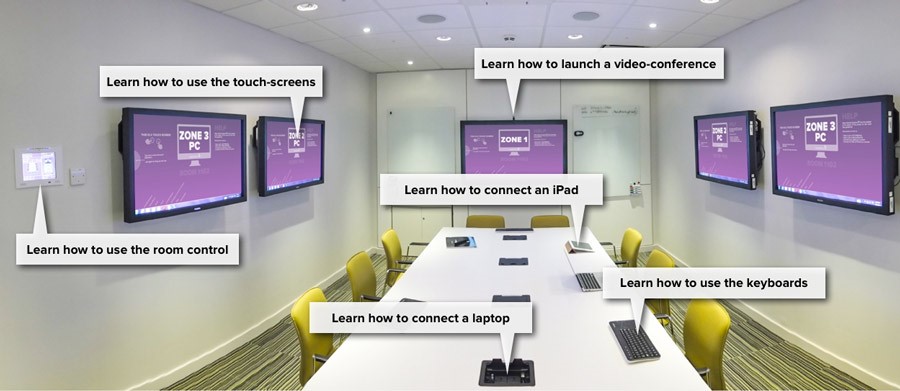Interactive Collaborative Environments (ICEs) are real world, functional, multi-touch enabled spaces. As well as creating an ICE at Edinburgh Napier University we have undertaken considerable consultancy and research work for a range of commercial clients as they seek to deliver their own industry-specific, innovative environments.
The Edinburgh Napier University ICE
We set about creating a meeting space that would be useful for faculty members, but would also allow us to explore collaboration. As with all real-world projects, our ICE had to comply with a number of constraints such as the existence of a physical room and a budget. It was also to be a ‘bring your own device’ (BYOD) environment. The philosophy underlying the design focused on providing an environment that would help people within it fulfill their activities and do so in pleasurable intuitive ways. Another key aim is to enable the blending of digital and analogue media. People bring notebooks, pens and paper to meetings and we were keen that such analogue media should co-exist happily alongside the digital spaces.
Case study
In March 2012 Professor David Benyon and Dr Oli Mival were commissioned by a large multi-national pharmaceutical company to consult on their meeting space strategy and to design a series of prototype spaces to enhance their creative and collaborative practice both locally and remotely.
In August 2012 we created a prototype ICE as a real world test-bed, to serve as a template for the development of subsequent similar spaces as the company rolled out refits of their various assets.
Below is Meeting Room 11G2; which has a psychical space of a a 10 person meeting room. The key objects in the pace were the tables, chairs and the walls. This afforded a design of the digital space that placed on 55” screen on the end wall and two 42” screens on either side wall. Wireless keyboards and mice were available to interact with the screens. A Crestron™ control panel was mounted on the left hand wall. Thus the blended space here used an immersive and interactive 3 zone, 5 multi-touch screen model which mirrored the source on zones 2 and 3 (of the 4, 42” wall screens) to enable interaction with multiple information from either side of the conference table. Zone 1 is the large 55” screen on the central feature wall and is for primary content such as traditional single person led presentations and video conferencing).

TACIT
The TACIT framework — derived from our own experiences and those of other researchers and designers — orientates designers to the key issues that need to be considered in ICEs;
- Territoriality
- Awareness
- Control
- Interaction
- Transitions
Our own design methodology (Mival and Benyon, 2013) reflects the fact that every use case for an ICE is different. One reason for applying blending theory and the TACIT framework to the design of ICEs is to help designers deal with the variety of physical and digital spaces that they will be dealing with.
David Benyon
Blended spaces have new properties that emerge from the particular combination of physical and digital and may give rise to a new sense of presence.